Keyword
Ionosphere
13 record(s)
Provided by
Type of resources
Topics
Keywords
Contact for the resource
Update frequencies
-
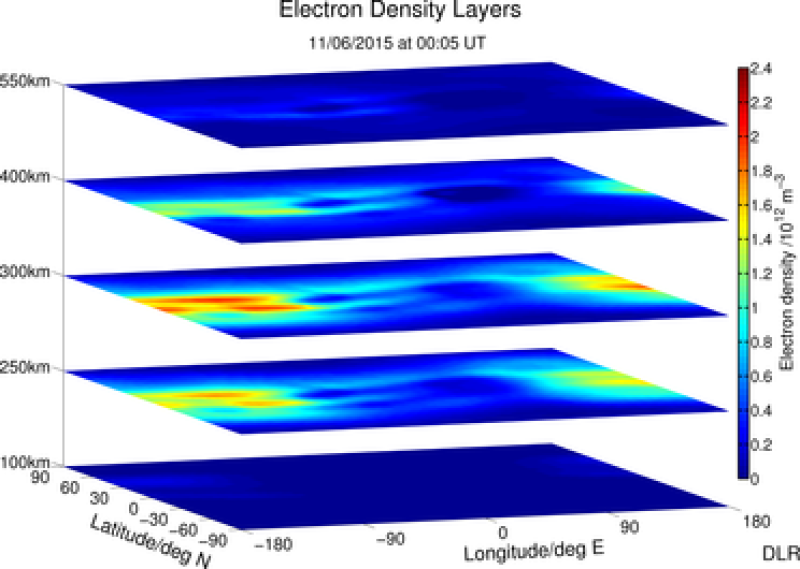
SWACI is a research project of DLR supported by the State Government of Mecklenburg-Vorpommern. Radio signals, transmitted by modern communication and navigation systems may be heavily disturbed by space weather hazards. Thus, severe temporal and spatial changes of the electron density in the ionosphere may significantly degrade the signal quality of various radio systems which even may lead to a complete loss of the signal. By providing specific space weather information, in particular now- and forecast of the ionospheric state, the accuracy and reliability of impacted communication and navigation systems shall be improved. According to the pioneer work of Sir E. Appleton the vertical structure of the terrestrial ionosphere may be divided into different layers (D, E, F1, F2) with different physical characteristics. The layers are primarily characterized by its height and peak electron density. The spatial plasma distribution is generated from actual TEC maps by applying a first version of the empirical electron density model NEDM-v1. In correspondence with the update rate of TEC maps the time resolution of the 3 D images is 5 minutes. For details see http://swaciweb.dlr.de/index.php?id=303&L=1 and http://presentations.copernicus.org/EGU2011-7324_presentation.pdf.
-
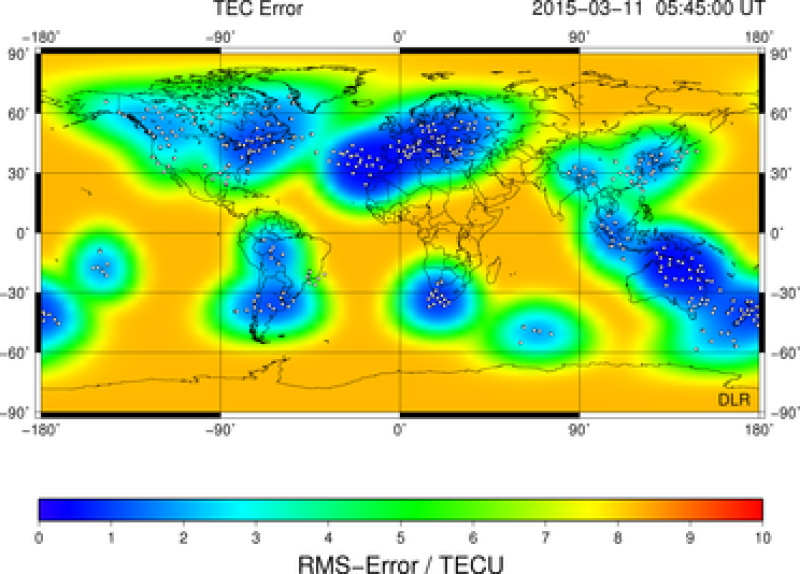
SWACI is a research project of DLR supported by the State Government of Mecklenburg-Vorpommern. Radio signals, transmitted by modern communication and navigation systems may be heavily disturbed by space weather hazards. Thus, severe temporal and spatial changes of the electron density in the ionosphere may significantly degrade the signal quality of various radio systems which even may lead to a complete loss of the signal. By providing specific space weather information, in particular now- and forecast of the ionospheric state, the accuracy and reliability of impacted communication and navigation systems shall be improved. The total electron content (TEC) is defined as the integral of the electron density along the ray path between satellite and receiver. Thus, TEC provides the number of electrons per square meter. The most frequently used unit is 1TECU = 1x1016 electrons / m2. TEC is derived from dual frequency code and carrier phase measurements provided by Global Navigation Satellite Systems (GNSS). SWACI uses GPS measurements from various European GNSS networks such as the International GNSS Service (IGS), European Reference Frame (EUREF), Norwegian Mapping Authority (NMA), and ascos distributed by the Federal Agency of Cartography and Geodesy (BKG) Frankfurt. The global TEC maps are mainly created by using data provided by the International GNSS Service Real-Time Pilot Project (IGS-RTPP). To generate TEC maps of vertical TEC, the slant measurements have to be transformed to the vertical. In a first approximation the ionospheric range error in GNSS is proportional to TEC. These TEC maps are used to derive latitudinal and zonal gradients, rate of change of TEC (5 min increments), 27 days medians, hourly forecasts of TEC, and corresponding error estimates. Spatial resolution (latitude x longitude): 2 °x 2° (Europe), 2.5° x 5° (globally)
-

SWACI is a research project of DLR supported by the State Government of Mecklenburg-Vorpommern. Radio signals, transmitted by modern communication and navigation systems may be heavily disturbed by space weather hazards. Thus, severe temporal and spatial changes of the electron density in the ionosphere may significantly degrade the signal quality of various radio systems which even may lead to a complete loss of the signal. By providing specific space weather information, in particular now- and forecast of the ionospheric state, the accuracy and reliability of impacted communication and navigation systems shall be improved. GPS radio occultation measurements onboard geo research satellites such as CHAMP and GRACE are used for retrieving vertical electron density profiles of the ionosphere. At present, only GPS measurements from GRACE are available. These data are routinely provided by GFZ Potsdam. Thus, the derived electron density profiles retrieved in SWACI are a common data product of DLR and GFZ Potsdam. Users are asked to acknowledge this in a proper way.
-
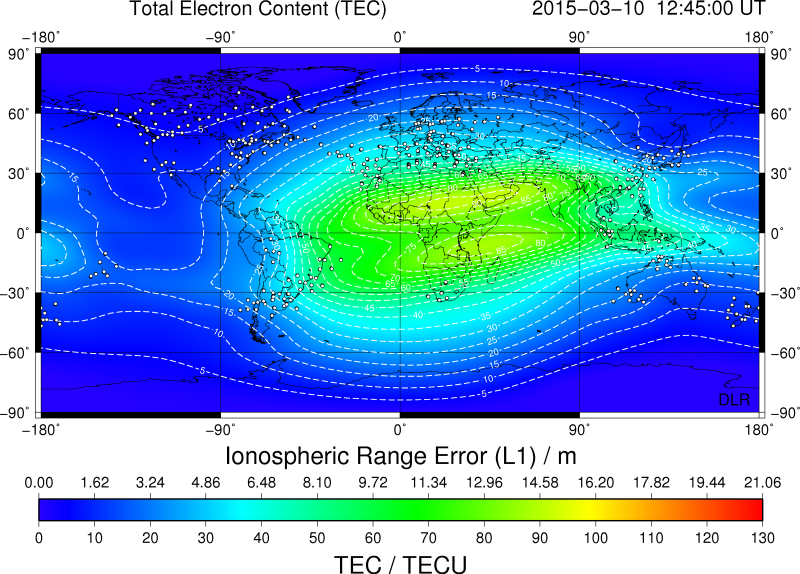
SWACI is a research project of DLR supported by the State Government of Mecklenburg-Vorpommern. Radio signals, transmitted by modern communication and navigation systems may be heavily disturbed by space weather hazards. Thus, severe temporal and spatial changes of the electron density in the ionosphere may significantly degrade the signal quality of various radio systems which even may lead to a complete loss of the signal. By providing specific space weather information, in particular now- and forecast of the ionospheric state, the accuracy and reliability of impacted communication and navigation systems shall be improved. The total electron content (TEC) is defined as the integral of the electron density along the ray path between satellite and receiver. Thus, TEC provides the number of electrons per square meter. The most frequently used unit is 1TECU = 1x1016 electrons / m2. TEC is derived from dual frequency code and carrier phase measurements provided by Global Navigation Satellite Systems (GNSS). SWACI uses GPS measurements from various European GNSS networks such as the International GNSS Service (IGS), European Reference Frame (EUREF), Norwegian Mapping Authority (NMA), and ascos distributed by the Federal Agency of Cartography and Geodesy (BKG) Frankfurt. The global TEC maps are mainly created by using data provided by the International GNSS Service Real-Time Pilot Project (IGS-RTPP). To generate TEC maps of vertical TEC, the slant measurements have to be transformed to the vertical. In a first approximation the ionospheric range error in GNSS is proportional to TEC. These TEC maps are used to derive latitudinal and zonal gradients, rate of change of TEC (5 min increments), 27 days medians, hourly forecasts of TEC, and corresponding error estimates. Spatial resolution (latitude x longitude): 2 °x 2° (Europe), 2.5° x 5° (globally)
-

SWACI is a research project of DLR supported by the State Government of Mecklenburg-Vorpommern. Radio signals, transmitted by modern communication and navigation systems may be heavily disturbed by space weather hazards. Thus, severe temporal and spatial changes of the electron density in the ionosphere may significantly degrade the signal quality of various radio systems which even may lead to a complete loss of the signal. By providing specific space weather information, in particular now- and forecast of the ionospheric state, the accuracy and reliability of impacted communication and navigation systems shall be improved. GPS radio occultation measurements onboard geo research satellites such as CHAMP and GRACE are used for retrieving vertical electron density profiles of the ionosphere. At present, only GPS measurements from GRACE are available. These data are routinely provided by GFZ Potsdam. Thus, the derived electron density profiles retrieved in SWACI are a common data product of DLR and GFZ Potsdam. Users are asked to acknowledge this in a proper way.
-
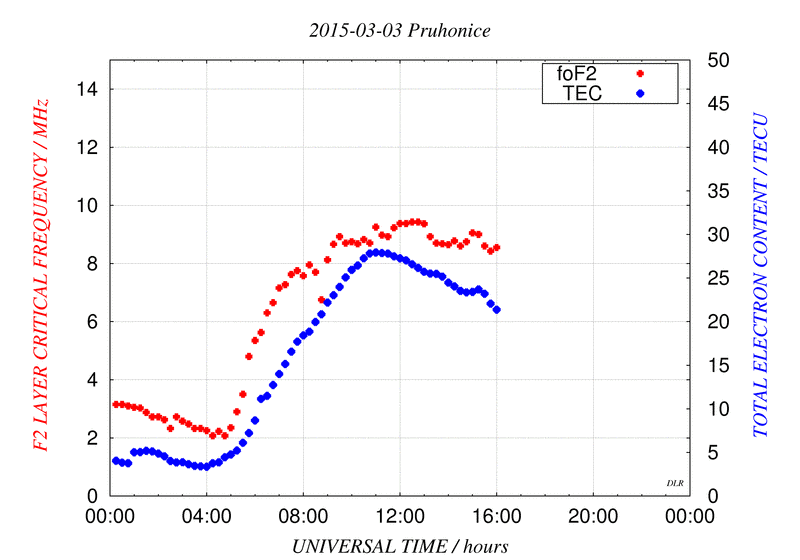
SWACI is a research project of DLR supported by the State Government of Mecklenburg-Vorpommern. Radio signals, transmitted by modern communication and navigation systems may be heavily disturbed by space weather hazards. Thus, severe temporal and spatial changes of the electron density in the ionosphere may significantly degrade the signal quality of various radio systems which even may lead to a complete loss of the signal. By providing specific space weather information, in particular now- and forecast of the ionospheric state, the accuracy and reliability of impacted communication and navigation systems shall be improved. The equivalent slab thickness is a measure of the width of the shape of the vertical electron density profile of the ionosphere. The equivalent slab thickness is defined by the ratio of the total electron content (TEC) and the peak electron density of the local ionosphere. To compute the peak electron density, vertical sounding data from different ionosonde stations are used. The corresponding TEC data are extracted from the SWACI TEC maps. For more details see http://swaciweb.dlr.de/data-and-products/public/slabthickness/?L=1.
-

SWACI is a research project of DLR supported by the State Government of Mecklenburg-Vorpommern. Radio signals, transmitted by modern communication and navigation systems may be heavily disturbed by space weather hazards. Thus, severe temporal and spatial changes of the electron density in the ionosphere may significantly degrade the signal quality of various radio systems which even may lead to a complete loss of the signal. By providing specific space weather information, in particular now- and forecast of the ionospheric state, the accuracy and reliability of impacted communication and navigation systems shall be improved. The total electron content (TEC) is defined as the integral of the electron density along the ray path between satellite and receiver. Thus, TEC provides the number of electrons per square meter. The most frequently used unit is 1TECU = 1x1016 electrons / m2. TEC is derived from dual frequency code and carrier phase measurements provided by Global Navigation Satellite Systems (GNSS). SWACI uses GPS measurements from various European GNSS networks such as the International GNSS Service (IGS), European Reference Frame (EUREF), Norwegian Mapping Authority (NMA), and ascos distributed by the Federal Agency of Cartography and Geodesy (BKG) Frankfurt. The global TEC maps are mainly created by using data provided by the International GNSS Service Real-Time Pilot Project (IGS-RTPP). To generate TEC maps of vertical TEC, the slant measurements have to be transformed to the vertical. In a first approximation the ionospheric range error in GNSS is proportional to TEC. These TEC maps are used to derive latitudinal and zonal gradients, rate of change of TEC (5 min increments), 27 days medians, hourly forecasts of TEC, and corresponding error estimates. Spatial resolution (latitude x longitude): 2 °x 2° (Europe), 2.5° x 5° (globally)
-
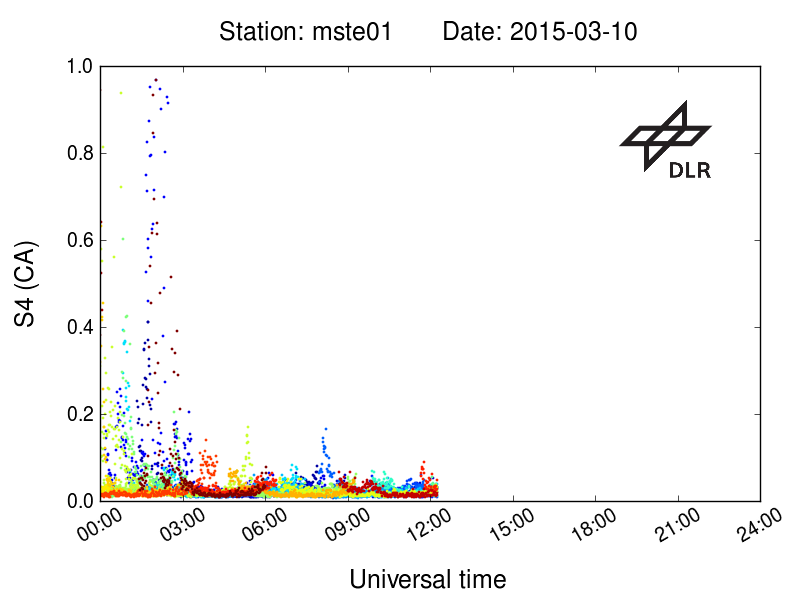
SWACI is a research project of DLR supported by the State Government of Mecklenburg-Vorpommern. Radio signals, transmitted by modern communication and navigation systems may be heavily disturbed by space weather hazards. Thus, severe temporal and spatial changes of the electron density in the ionosphere may significantly degrade the signal quality of various radio systems which even may lead to a complete loss of the signal. By providing specific space weather information, in particular now- and forecast of the ionospheric state, the accuracy and reliability of impacted communication and navigation systems shall be improved. Small scale irregularities of the ionospheric plasma may cause fluctuations of the signal strength of radio waves. The S4-Index is a measure to describe the amplitude- respectively the intensity fluctuations of a signal. The σφ-Index, describes the behaviour of carrier phase fluctuations. Both indices are calculated over a one minute interval. DLR’s high rate GNSS measurement network ranges from auroral to equatorial latitudes. The measurements are provided in near real time by DLR’s Experimentation and Verification Network (EVnet) [Noack et al., 2004, 2005]. We thank the hosting institutes for supplying the required infrastructure.
-
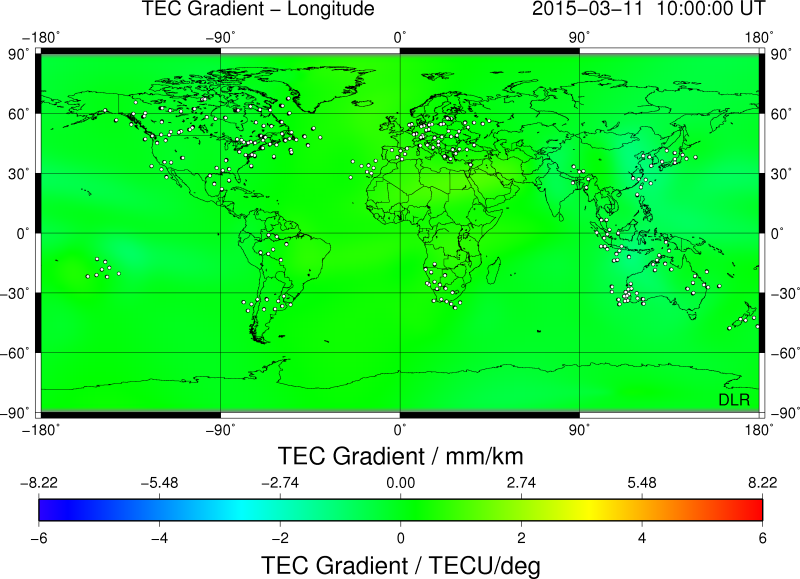
SWACI is a research project of DLR supported by the State Government of Mecklenburg-Vorpommern. Radio signals, transmitted by modern communication and navigation systems may be heavily disturbed by space weather hazards. Thus, severe temporal and spatial changes of the electron density in the ionosphere may significantly degrade the signal quality of various radio systems which even may lead to a complete loss of the signal. By providing specific space weather information, in particular now- and forecast of the ionospheric state, the accuracy and reliability of impacted communication and navigation systems shall be improved. The total electron content (TEC) is defined as the integral of the electron density along the ray path between satellite and receiver. Thus, TEC provides the number of electrons per square meter. The most frequently used unit is 1TECU = 1x1016 electrons / m2. TEC is derived from dual frequency code and carrier phase measurements provided by Global Navigation Satellite Systems (GNSS). SWACI uses GPS measurements from various European GNSS networks such as the International GNSS Service (IGS), European Reference Frame (EUREF), Norwegian Mapping Authority (NMA), and ascos distributed by the Federal Agency of Cartography and Geodesy (BKG) Frankfurt. The global TEC maps are mainly created by using data provided by the International GNSS Service Real-Time Pilot Project (IGS-RTPP). To generate TEC maps of vertical TEC, the slant measurements have to be transformed to the vertical. In a first approximation the ionospheric range error in GNSS is proportional to TEC. These TEC maps are used to derive latitudinal and zonal gradients, rate of change of TEC (5 min increments), 27 days medians, hourly forecasts of TEC, and corresponding error estimates. Spatial resolution (latitude x longitude): 2 °x 2° (Europe), 2.5° x 5° (globally)
-
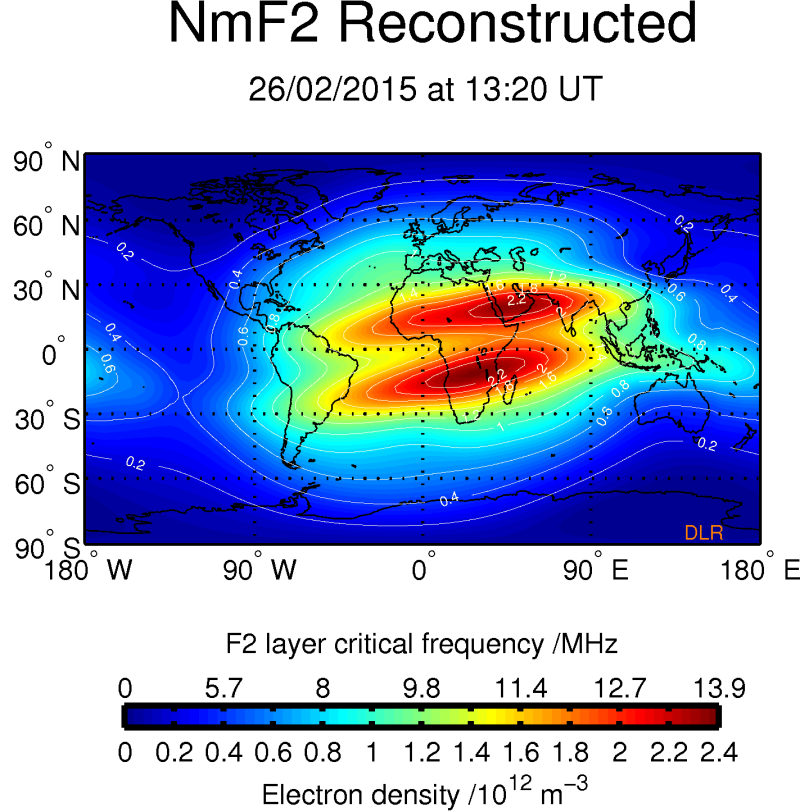
SWACI is a research project of DLR supported by the State Government of Mecklenburg-Vorpommern. Radio signals, transmitted by modern communication and navigation systems may be heavily disturbed by space weather hazards. Thus, severe temporal and spatial changes of the electron density in the ionosphere may significantly degrade the signal quality of various radio systems which even may lead to a complete loss of the signal. By providing specific space weather information, in particular now- and forecast of the ionospheric state, the accuracy and reliability of impacted communication and navigation systems shall be improved. NmF2 Maps and 3D electron density distribution: According to the pioneer work of Sir E. Appleton the vertical structure of the terrestrial ionosphere may be devided into different layers (D, E, F1, F2) with different physical characteristics. The layers are primarily characterized by its height and peak electron density. Typical plasma frequencies /electron densities are in the order of 10 MHz /1012 electrons / m3. Shown are here global maps of the peak electron density of the F2 layer and related electron density maps at selected altitudes. The figures provide a first estimation of the three dimensional electron density distributions around the globe. For more details see http://swaciweb.dlr.de/data-and-products/public/nmf2/?L=1.
 www.geodatenkatalog.de (S1L)
www.geodatenkatalog.de (S1L)